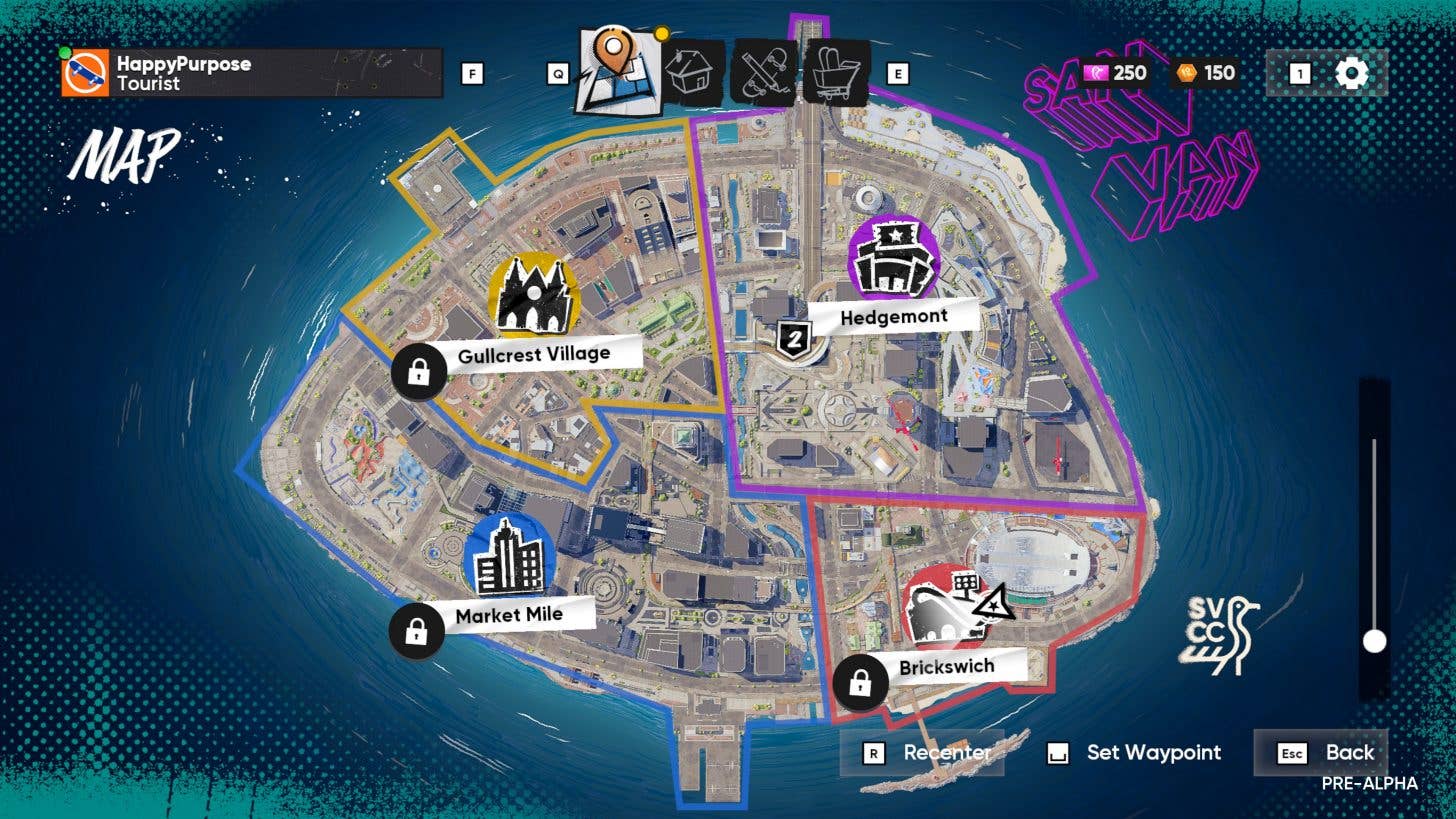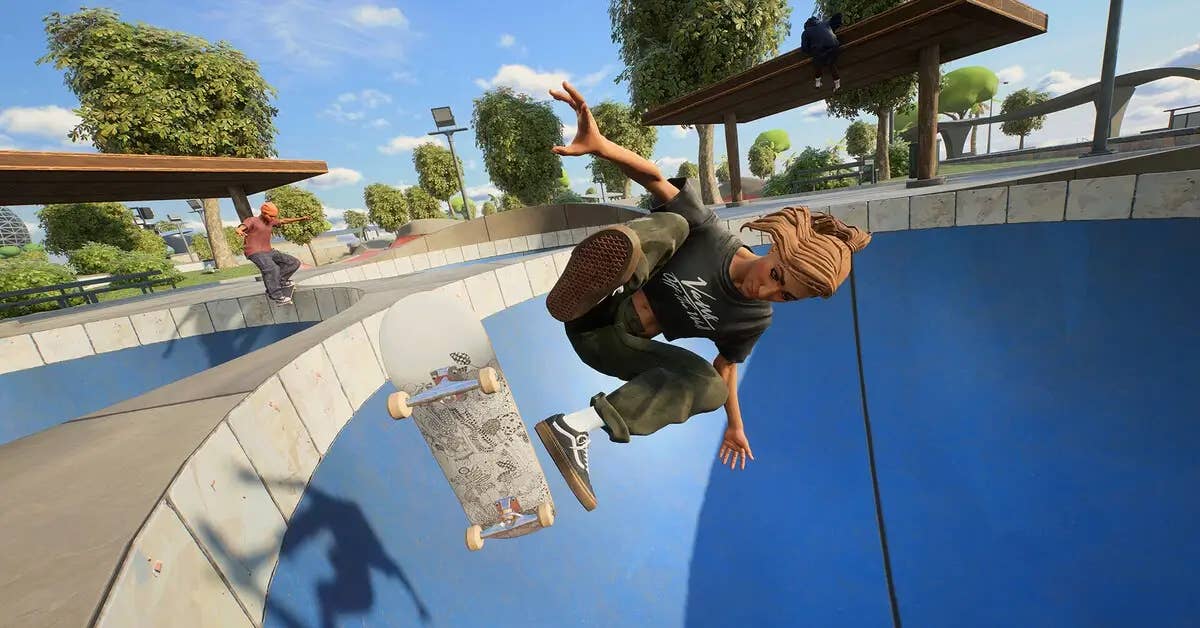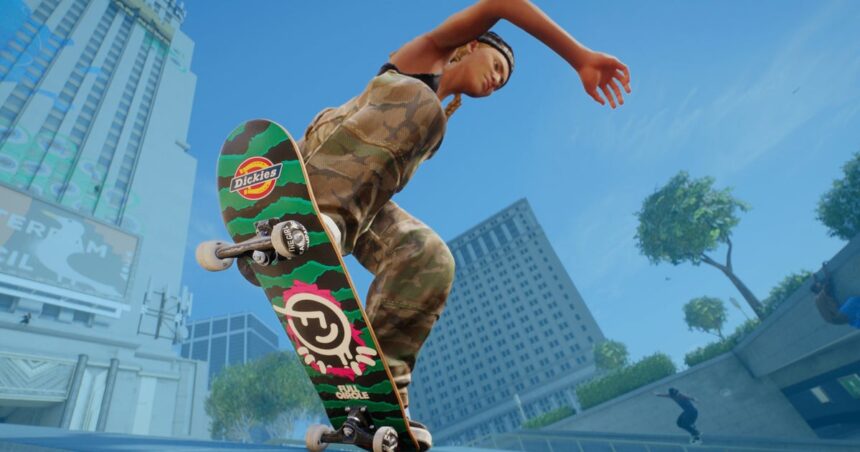The new Skate game is free-to-play and pretty much massively multiplayer. It’s a cross-platform live service game to its core, and it drops you into a shared open-world map with up to 150 other skaters. And, as you might expect from all these things being name-checked, my first half hour with the game involved trying to understand a muddle of regular unlocks, an in-game currency, a levelling system, a fast travel system and various other bits of UI shenanigans.
Please note, EA has been clear from the off that the game’s real-money shop will only ever let players pay for cosmetics, which is great. The team’s promise is that you will not be able to buy power or pay to win. Even so, the onboarding still involves trips back and forth to an unlock shop, albeit one with a clever name I won’t spoil. It involves lots of freely dished-out in-game currency spent on boxes that, once opened, contain new clothes, skateboard art, levelling points and the odd new ramp or whatnot to drop into spots. But a lot of it went over my distracted head. It’s Skate, but even when you’re dealing with just in-game currency, this really isn’t the skating part.
To see this content please enable targeting cookies.
Luckily, none of this matters. Skate’s trajectory for me at least involved half an hour of muddling through all of this stuff before learning that the game, as is so often the case with skating, is a two-step affair. You move around the level – in this case an entire open-world city called San Vansterdam – completing challenges to unlock missions that take you out across the sights and introduce you to a council of skating elders who run the place. But what you’re really learning, what I’m really learning, is to step away from all that and just enjoy freeform skating, with the flips, grabs and other tricks the legendary Flick-It system is so good at conjuring. All of this unspooling in a bright, cheerful world that’s perfectly made to be skated over and under, around and around. I was learning to leave the game stuff behind and just play.
To this end, Skate is a game that wants to distract you. It wants to trick you into finding your own path through it. This clicked for the first time when I left behind the AR trail that lead me to the next bit of official business and just started to climb. The new Skate has a lot of off-board stuff, largely revolving around gentle parkour. There was a building behind me at the time – a huge tower with a Miami white facade and grass sections growing on it. These grass sections had Zigzag metal planters set through them that looked pretty useful. I climbed for a few minutes and suddenly I had what I didn’t know I had wanted: a view over a huge stretch of city. Then I pulled up the map and saw there were some stunt challenges nearby. So off I went. The pleasures of distraction!
Stunt challenges are those hilarious chaotic challenges that are less about skating and more about chucking yourself into the abyss for points. In one, I had to just bounce my way down a skyscraper hoping to land in a dumpster. In another, a while later, I had to plummet for a while, then get on my board, then do a grab and a flip trick and land somewhere fiercely specific. These things are just lovely: five to ten to thirty minutes of comical bone-shredding failure followed by an exhilarating one-shot success. Stunting!
Skate seems filled with these things – challenges, of course, and of all different types and often rotating in and out with the passing of time. But also just stuff. On a radial dial you can access a video editor for cutting together and exporting clips of your tricks. There’s also a music system that allows you to literally grab in-game tracks as you pass them in the world and hold onto them and probably whack them into playlists. There’s also a Quick Drop editor which allows you to add ramps and rails and what-have-you to make your own spot pretty much anywhere on the map. All of this before, you know, the massively multiplayer bit and the 150 other players sharing the city with you.
At the core of it all, however, is Skate’s legendary Flick-It system. The system in which you ping the right stick around in different directions to pull off different tricks. This has been part of Skate since the start, and the current Skate team talks about it with a certain reverence. In fact, Skate’s executive producer Mike McCartney (no relation), explains to me that, back in the day, Flick-It was fun before it even had much of a game to sit within.
“Basically, the idea was, when we first designed the Flick-It system, the first prototype that we made was a text-based prototype where you input it into the on the controller,” he says. “And it would just say ‘Ollie’ on screen. Or ‘Kick Flip’, or ‘Heel Flip’ or whatever. And as we added tricks, we kept checking that to see if the fidelity was good and it was recognizing the proper tricks.
“And as a team, one of the early things that we did was we played games of SKATE,” McCartney continues, “where I do a trick and then you have to match that trick. So we would play games of SKATE on this prototype, and we were having fun as a team doing that, even without an actual character or a skateboard or physics or anything. We were having fun and laughing and joking around. That was sort of the spark that sort of kicked off, like, ‘Hey, I think we got something here with this, with this core toy.'”
Flick-It is still effortless fun, allowing you to make even the quietest moment into a few seconds of something cool happening at board level. It’s great for practicing and it’s great for showing off to other players. But, speaking of other players, it’s interesting to me that I’ve spent my most memorable moments so far in this busy game on my own.

Example: there’s a lovely mission about an hour in that just has you skating from one spot in the city to another to get a sense of the place, and tricking and earning points as you go. The area I started in is a kind of cross between downtown LA on a gloriously unbusy day and somewhere like Seattle with the skyscrapers running up against the water. There are lovely plazas to uncover. There are buildings to climb and maybe chain moves between. There’s a genuine sense of place to these areas.
Threading through the whole thing, meanwhile, is the Skateway, a looping track that’s based on New York’s Highline park, and which allows you to mobius your way around a pretty large open world without resorting to fast travel spots.
The open world aspect of Skate is important, and it’s fascinating to me, too. Because in skating games, an open world is more than a place to move from A to B through, and more than a place in which to mount a series of bespoke missions. It’s a place to dawdle in and doodle around on a board, looking for lines on even the most forgettable and unpromising of street corners. It’s a place to stop and linger, a place where anywhere could suddenly become somewhere special, just because you’ve decided to hang out there.
This stuff is tricky, I imagine. And when I put this to Jeff Seamster, the head of creative on Skate, he agrees. And he suggests it’s all about creating connections – or the possibilities for connections in each part of the world.
“A lot of it is created where our world design team and our world art team will sort of move through the world and let the opportunities speak to them,” Seamster explains. “It’s not a thing where we’re just having you FedEx [yourself] around the whole world. It’s like: okay, let’s make sure that there’s a clear line to get from here to here to here to here to here to here to here.
“It’s very much about creating these places with a lot of rich moments and environments,” he says. “And sometimes they can be really small, like it can just be like a corner of a stair, and it’s just like: man, people are going to just session the hell out of this place! And we’re talking about this tiny piece of the world. If you think about the scope and the scale of a Spider-Man [game] or whatever else, this is a thing that flicks by in a moment.
“But our game is much more about this almost intimate connection to the city. And there are even places where we will look around the world and decide, this is just going to be a great place to hang out. So it’s not necessarily designed for action, but we want places where players can hang out, chit-chat together, watch other players session a spot. So we’ll have these perches that are there around the world. This is just a great place to meet up, and they have landmark design around them.”

Skate’s open world will also change over time. I’m picturing something a bit like Fortnite. Skate will have seasons that all come with their own themes to their additions and tweaks. (It will also have a Skate Pass, which is essentially a Battle Pass, right down to the paid and unpaid tiers.) It’s going to be fascinating to see San Vansterdam change in that shoemaker’s elves way that Fortnite changes. It’s clear that the team wants this to be a place where people come to just hang out, as they do in Fortnite. To this end, along with Seamster’s perches, there’s even a spectator mode, which allows you to just zone out and watch any of the skaters on your server doing their tricks.
A lot of time has passed since the last Skate game. And what’s interesting is that it’s very clear now that this kind of game is not a million miles away from the current cozy game phenomenon. Like a lot of cozy games, it’s about enjoying the beauty of a game world and slowing down to let the moments find you.
Real talk: I am a terrible but extremely committed 35mm film photographer these days, and San Vansterdam made me want to skate, sure, but it also made me want to bust out my Canon point-and-shoot, in exactly the way a lot of cozy games do. And this is something EA appears to be aware of too.
“I think we all to some degree talk about film and filmic things and how things look through the camera quite a lot,” Seamster laughs. “We all just happen to love things that happen on camera. But it also is a very specific tie to the history of skate culture. Photography and videography of skating over the years have [been interlinked].”
Perhaps because of that, the team’s attuned to the way that photography can change a place just like skating can – like any activity done with thought and passion can. “I can’t believe I’m going here,” he laughs, “but, like, macro gardening photography is a very specific way of looking at the world, for example. And if you talk about Skate and skateboarding, we talk about how we frame screenshots and how we capture our own footage: there’s a way of positioning the camera, to bias the action and show action opportunity, and to frame things up. And it turns into this cool new appreciation. And I have even found myself in my own photography – I take photos in cities – approaching things in a very different way than I would have otherwise [as a result of Skate.] I’m getting down close to things.
“And it’s like, this is a cool thing to look at, but this is also a great thing to grind, or a great thing to launch over.” He laughs. “Or whatever else it might be.”





